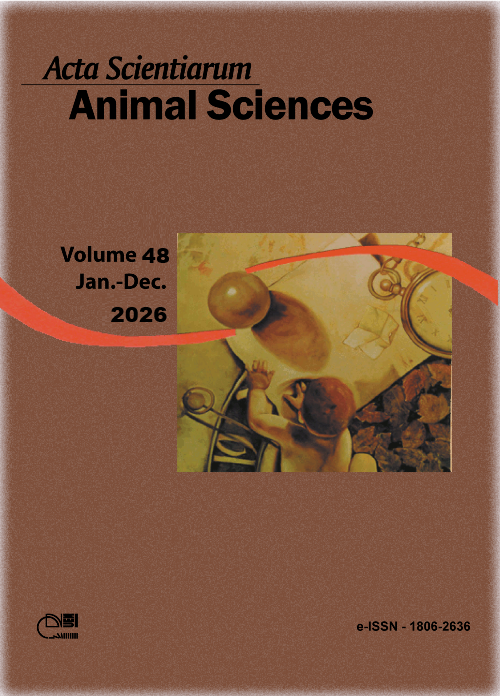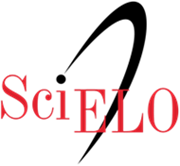Ruminal fermentation, nutrients digestibility, and nitrogen balance in lambs fed diet containing high concentrate and essential oil concentrations of lemon grass (Cymbopogon citratus)
Resumo
This experiment evaluated the effects of doses of essential oil of lemon grass (Cymbopogon citratus) in rumen fermentation, nutrients digestibility and nitrogen balance in lambs. The treatments: negative control/CTL (no additives); positive control/MON (addition of 25 ppm of monensin Kg- of dry matter); and 1.25, 2.5 and 3.75 mL essential oil Kg of diet as feed. Twenty-five crossbreed Dorper x Santa Ines lambs with 45.6 ± 10.7 Kg of body weight and cannulated in the rumen allocated into randomized complete blocks design with five replicates per treatment. It was possible to verify that all the treatments began to alter some parameters of the ruminal fermentation of the diet offering. Essential oil of lemon grass used had similar results to monensin on parameters of ruminal, on day 21 compared with day zero, essential oil presented high concentrations of ammoniacal nitrogen in the rumen, indicating that there was protein degradation greater than monensin. Not verified effect of essential oil in nutrient intake and nitrogen retained, even though there was improvement in the digestibility of dry matter and crude protein, and these effects were similar to monensin. During the 21 days, essential oil evaluated is effective manipulating some parameters of the ruminal fermentation.
Downloads
Referências
Abdl-Rahman, M. A. (2010). In vitro manipulation of rumen fermentation efficiency by fumaric acid–bentonite coupled addition as an alternative to antibiotics. Journal of Agricultural Science, 2(2), 174–180. https://doi.org/10.5539/jas.v2n2p174
Anassori, E., Dalir-Naghadeh, B., Pirmohammadi, R., Taghizadeh, A., Asr-Rezaei, S., Maham, M., Farahmand-Azar, S., & Farhoomand, P. (2011). Garlic: a potential alternative for monensin as a rumen modifier. Livestock Science, 142(1-3), 276-287. https://doi.org/10.1016/j.livsci.2011.08.003
Association of Official Analytical Chemists. (1990). Official methods of analysis (Vol. 1). AOAC International.
Association of Official Analytical Chemists. (1997). Official methods of analysis. AOAC International.
Benchaar, C., Chaves, A. V., Fraser, G. R., Wang, Y., Beauchemin, K. A., & McAllister, T. A. (2007). Effects of essential oils and their components on in vitro rumen microbial fermentation. Canadian Journal of Animal Science, 87(3), 413-419. https://doi.org/10.4141/cjas07012
Bodas, R., Prieto, N., García-González, R., Andrés, S., Giráldez, F. J., & López, S. (2012). Manipulation of rumen fermentation and methane production with plant secondary metabolites. Animal Feed Science and Technology, 176(1-4), 78-93. https://doi.org/10.1016/j.anifeedsci.2012.07.010
Cardozo, P. W., Calsamiglia, S., Ferret, A., & Kamel, C. (2004). Effects of natural plant extracts on ruminal protein degradation and fermentation profiles in continuous culture. Journal of Animal Science, 82(11), 3230-3236. https://doi.org/10.2527/2004.82113230x
Calsamiglia, S., Busquet, M., Cardozo, P. W., Castillejos, L., & Ferret, A. (2007). Invited review: essential oils as modifiers of rumen microbial fermentation. Journal of Dairy Science, 90(6), 2580-2595. https://doi.org/10.3168/jds.2006-644
Chaney, A. L., & Marbach, E. P. (1962). Modified reagents for determination of urea and ammonia. Clinical Chemistry, 8(2), 130-132. https://doi.org/10.1093/clinchem/8.2.130
Cobellis, G., Trabalza-Marinucci, M., Marcotullio, M. C., & Yu, Z. (2016). Evaluation of different essential oils in modulating methane and ammonia production, rumen fermentation, and rumen bacteria in vitro. Animal Feed Science and Technology, 215, 25-36. https://doi.org/10.1016/j.anifeedsci.2016.02.008
Demirtas, A., Ozturk, H., Sudagidan, M., Keyvan, E., Yavuz, O., Gulay, O. Y., & Musa, S. A. A. (2019). Effects of commercial aldehydes from green leaf volatiles (green odor) on rumen microbial population and fermentation profile in an artificial rumen (Rusitec). Anaerobe, 55, 83-92. https://doi.org/10.1016/j.anaerobe.2018.11.001
Firkins, J. L., Allen, M. S., Oldick, B. S., & St-Pierre, N. R. (1998). Modeling ruminal digestibility of carbohydrates and microbial protein flow to the duodenum. Journal of Dairy Science, 81(12), 3350-3369. https://doi.org/10.3168/jds.S0022-0302(98)75901-6
Fraser, G. R., Chaves, A. V., Wang, Y., McAllister, T. A., Beauchemin, K. A., & Benchaar, C. (2007). Assessment of the effects of cinnamon leaf oil on rumen microbial fermentation using two continuous culture systems. Journal of Dairy Science, 90(5), 2315-2328. https://doi.org/10.3168/jds.2006-688
Guerra, M. J. M., Badell, J. B., Abajes, A. R. R., Pérez, H. B., Valencia, R. M., & Azcuy, A. L. (2000). Evaluación toxicológica aguda de los extractos fluidos al 30 y 80% de Cymbopogon citratus (DC.) Stapf (caña santa). Revista Cubana de Plantas Medicinales, 5(1), 97-101.
Hart, K. J., Yáñez-Ruiz, D. R., Duval, S. M., McEwan, N. R., & Newbold, C. J. (2008). Plant extracts to manipulate rumen fermentation. Animal Feed Science and Technology, 147(1-3), 8-35. https://doi.org/10.1016/j.anifeedsci.2007.09.007
Knapp, J. R., Laur, G. L., Vadas, P. A., Weiss, W. P., & Tricarico, J. M. (2014). Enteric methane in dairy cattle production: quantifying the opportunities and impact of reducing emissions. Journal of Dairy Science, 97(6), 3231-3261. https://doi.org/10.3168/jds.2013-7234
Lana, R. P., & Russell, J. B. (2001). Efeitos da monensina sobre a fermentação e sensibilidade de bactérias ruminais de bovinos sob dietas ricas em volumosos ou concentrados. Revista Brasileira de Zootecnia, 30(1), 254-260. https://doi.org/10.1590/S1516-35982001000100036
Leal, T. C. A. B., Freitas, S. P., Silva, J. F., & Carvalho, A. J. C. (2003). Produção de biomassa e óleo essencial em plantas de capim cidreira (Cymbopogon citratus) em diferentes idades. Revista Brasileira de Plantas Medicinais, 5(1), 61-64.
Lorenzi, H. (2002). Árvores brasileiras: manual de identificação e cultivo de plantas arbóreas do Brasil (Vol. 1). Instituto Plantarum.
Malecky, M., Broudiscou, L. P., & Schmidely, P. (2009). Effects of two levels of monoterpene blend on rumen fermentation, terpene and nutrient flows in the duodenum and milk production in dairy goats. Animal Feed Science and Technology, 154(1-2), 24-35. https://doi.org/10.1016/j.anifeedsci.2009.07.004
Meyer, N. F., Erickson, G. E., Klopfenstein, T. J., Greenquist, M. A., Luebbe, M. K., Williams, P. P., & Engstrom, M. A. (2009). Effect of essential oils, tylosin and monensin on finishing steer performance, carcass characteristics, liver abscesses, ruminal fermentation and digestibility. Journal of Animal Science, 87(7), 2346-2354. https://doi.org/10.2527/jas.2008-1493
Naik, M. I., Fomda, B. A., Jaykumar, E., & Bhat, J. A. (2010). Antibacterial activity of lemongrass (Cymbopogon citratus) oil against some selected pathogenic bacteria. Asian Pacific Journal of Tropical Medicine, 3(7), 535-538. https://doi.org/10.1016/S1995-7645(10)60129-0
Russell, J. B. (2002). Rumen microbiology and its role in ruminant nutrition. Department of Microbiology, Cornell University.
Santos, M. B., Robinson, P. H., Williams, P., & Losa, R. (2010). Effects of addition of an essential oil complex to the diet of lactating dairy cows on whole tract digestion of nutrients and productive performance. Animal Feed Science and Technology, 147(1-2), 64-71. https://doi.org/10.1016/j.anifeedsci.2010.02.001
Statistical Analysis System Institute. (2002). SAS system for Windows (Version 9). SAS Institute.
Tager, L. R., & Krause, K. M. (2011). Effects of essential oils on rumen fermentation, milk production, and feeding behavior in lactating dairy cows. Journal of Dairy Science, 94(5), 2455-2464. https://doi.org/10.3168/jds.2010-3505
Tekippe, J. A., Hristov, A. N., Heyler, K. S., Cassidy, T. W., Zheljazkov, V. D., Ferreira, J. F. S., Karnati, S. K., & Varga, G. A. (2011). Rumen fermentation and production effects of Origanum vulgare L. leaves in lactating dairy cows. Journal of Dairy Science, 94(10), 5065-5079. https://doi.org/10.3168/jds.2010-4095
Van Soest, P. J. (1994). Nutritional ecology of the ruminant. Cornell University Press.
Van Soest, P. J., Robertson, J. B., & Lewis, B. A. (1991). Methods for dietary fiber, neutral detergent fiber, and nonstarch polysaccharides in relation to animal nutrition. Journal of Dairy Science, 74(10), 3583-3597. https://doi.org/10.3168/jds.S0022-0302(91)78551-2
Wu, Z., Sadik, M., Sleiman, F. T., Simas, J. M., Pessarakli, M., & Huber, J. T. (1994). Influence of yuca extract on ruminal metabolism in cows. Journal of Animal Science, 72(4), 1038-1044. https://doi.org/10.2527/1994.7241038x
Wolin, J. M. (1960). A theoretical rumen fermentation balance. Journal of Dairy Science, 43(11), 1452–1459. https://doi.org/10.3168/jds.S0022-0302(60)90348-9
Zago, J. A. A., Ushimaru, P. I., Barbosa, L. N., & Fernandes Jr, A. (2009). Sinergismo entre óleos essenciais e drogas antimicrobianas sobre linhagens de Staphylococcus aureus e Escherichia coli isoladas de casos clínicos humanos. Revista Brasileira de Farmacognosia, 19(4), 828–833. https://doi.org/10.1590/S0102-695X2009000600005
Copyright (c) 2026 José Alípio Faleiro Neto, Alexandre Vaz Pires, Elizangela Mirian Moreira, Rogerio de Paula Lana, Evandro Maia Ferreira, Clinton R. Krehbiel, Renato Shinkai Gentil, Marcos Vinicius de Castro Ferraz Junior

This work is licensed under a Creative Commons Attribution 4.0 International License.
DECLARAÇÃO DE ORIGINALIDADE E DIREITOS AUTORAIS
Declaro que o presente artigo é original, não tendo sido submetido à publicação em qualquer outro periódico nacional ou internacional, quer seja em parte ou em sua totalidade.
Os direitos autorais pertencem exclusivamente aos autores. Os direitos de licenciamento utilizados pelo periódico é a licença Creative Commons Attribution 4.0 (CC BY 4.0): são permitidos o compartilhamento (cópia e distribuição do material em qualqer meio ou formato) e adaptação (remix, transformação e criação de material a partir do conteúdo assim licenciado para quaisquer fins, inclusive comerciais.
Recomenda-se a leitura desse link para maiores informações sobre o tema: fornecimento de créditos e referências de forma correta, entre outros detalhes cruciais para uso adequado do material licenciado.








































